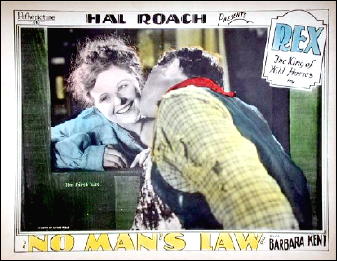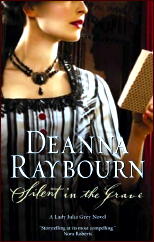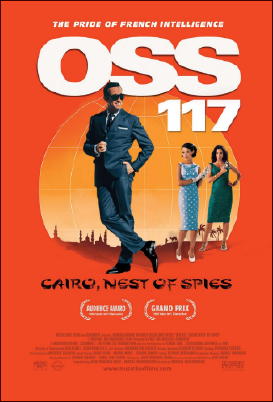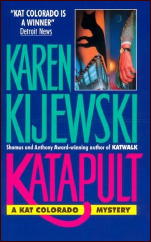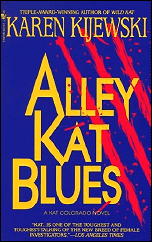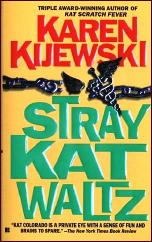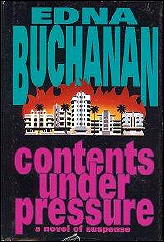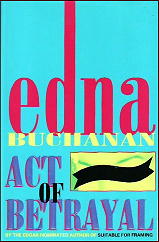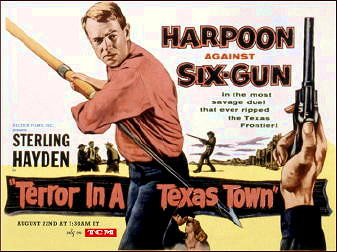July 2011
Monthly Archive
Wed 27 Jul 2011
REVIEWED BY WALTER ALBERT:
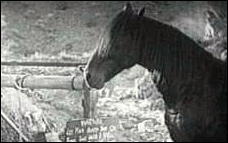
NO MAN’S LAW. Hal Roach production, distributed by PatM Exchange, 1927. Rex (King of the Wild Horses),Barbara Kent, James Finlayson, Oliver Hardy, and Theodore Von Eltz. Photography by Floyd Jackman and George Stevens; director: Fred Jackman. Shown at Cinevent 40, Columbus OH, May 2008.
I usually have a good memory for animal stars, but I don’t recall seeing the reportedly temperamental equine star before. Rex was a nom de cinema, with Casey Jones his original moniker. Rex’s career continued into the sound era, but No Man’s Land was the third and last of his Roach-produced oaters.
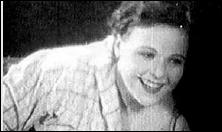
It may be surprising to see the names of James Finlayson and Oliver Hardy attached to a dramatic film, especially since Hardy is the villain of the piece, with not a good (or funny) bone in his body.
Hardy and Von Eltz play crooks on the lam who attempt to take over the claim where prospector Jake Belcher (Finlayson), helped only by his foster daughter Toby (Barbara Kent), has been digging for gold for many years.
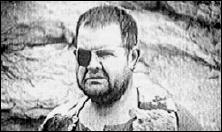
Rex is a wild horse, presumably beholden to no man (or woman), but for reasons that aren’t explained he keeps a close watch on Toby and Jake, finally driving Hardy into a gulch where he pounds him to death with his driving hooves. (No, we don’t see this; the camera focuses on Hardy’s clenched fist that slowly relaxes as he dies.)
Barbara Kent is still alive, living in Sun Valley, Idaho, and refusing to talk about her movie career. She has an extended nude swimming scene (well, it looks as if she’s nude, but with a long shot she may be wearing a skin-tight outfit) and the interest this aroused in the Cinevent audience (and probably in audiences at the time of the film’s original release) may explain why Rex seemed so cranky during much of this hokey, entertaining film.
Wed 27 Jul 2011
REVIEWED BY DAN STUMPF:
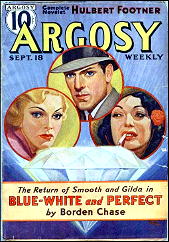
BORDEN CHASE – Diamonds of Death. Hart, paperback original, 1947. First serialized as “Blue-White and Perfect,” Argosy, 18 Sept-23 Oct, 1937. Filmed as Blue, White and Perfect, 1941.
A while back, I reviewed Borden Chase’s novel Red River and found it surprisingly hammy from a writer known for his laconic screenplays. So I decided to give him another try and fished out Diamonds of Death (Hart, 1947) the first novel edition of Chase’s pulp novel, “Blue-White and Perfect.”
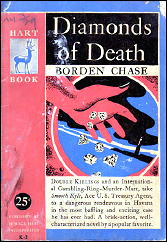
This is that rarity, a dumb mystery that doesn’t insult one’s intelligence. The “surprise” criminal may be obvious early on, but Chase speeds his story through so many curves one hasn’t time to carp, as hero Smooth Kyle (I guess some folks don’t care what they name their kids) chases diamond smugglers from Broadway to Havana and back again.
Chase provides his hero with a wise-cracking girlfriend, buddies in the Customs Office, and enough bad guys to felonize a dozen books like this, ranging from cheap hoods to smooth operators, phony dowagers, fake cops…
I could go on, but readers of this sort of thing have met them before, and those who haven’t probably couldn’t appreciate the pulpy splendor of the piece, as Chase fills his story with glittering diamonds, luxury liners, exploding airplanes and elegant mansions, all of which impart a feel of extravagance without actually costing anything to write about.
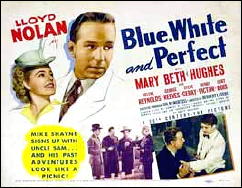
I’ll just add that the original pulp novel was bought by Fox for their “Michael Shayne” series back in the 40s, movies notable for pace, casting, and for the fact that the producers used only one Mike Shayne novel in the whole series, apparently preferring to impose their hero into stories by other authors, including Clayton Rawson, Frederick Nebel and even Raymond Chandler!
Anyway, Borden Chase’s story suits the character quite well, and reading this one can almost hear Lloyd Nolan’s snappy banter as he stalks through the studio back lot.
Editorial Comment: I think you can make it out on the cover of the Argosy magazine that contained the first installment of the pulp novel, but in case not, it refers to the fact that this was a return engagement for Smooth and Gilda. Collectors of Argosy, can you help me out? What earlier appearances were there?
Tue 26 Jul 2011
A 1001 MIDNIGHTS Review
by Marcia Muller
NATHAN ALDYNE – Slate. New York: Villard Books, 1984. Ballantine, paperback, 1985. Alyson, trade ppbk, 1999.
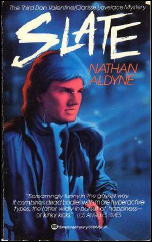
This is the third in a series of novels featuring gay bartender Dan Valentine and his straight friend Clarisse Lovelace. As the story opens, Dan is in the hospital recovering from a bout of double pneumonia; Clarisse is just starting law school. The two embark on a new venture at the urging of Clarisse’s uncle Noah — co-ownership of a gay bar in Boston’s South End.
The building, originally owned by Noah, is across from the District D police station and houses an odd mixture of tenants — including a lesbian couple (one is a swimming pool repair specialist, the other a call girl) who are allowed to stay, and a family of sixteen Gypsies that Clarisse evicts singlehandedly . Also present on the first floor next to the bar is Mr. Fred’s Tease ‘n’ Tint hairstyling establishment.
As one might expect from such an odd starting lineup, events do not proceed smoothly. The bar and apartments above (where Clarisse and Dan propose to live) are a shambles. Fortunately, Dan’s new lover, Linc, is a carpenter of some creativity; with any luck, the bar, to be named Slate, will open for New Year’s.
Enter Sweeney Drysdale II, columnist for BAR (Boston Area Reporter — a free newssheet on Boston’s bars). Sweeney’s column “makes bars … and breaks bars,” in his words. And he is determined to break Slate. Determined, that is, until he turns up dead in Clarisse’s bed on the evening Mr. Fred of hairstyling fame gives a little “do” to welcome his new neighbors.
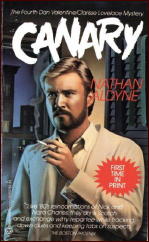
Events proceed against this zany background. Clarisse and Dan and sidekicks investigate with aplomb. But there’s a problem with this novel: It simply lacks substance. Not once are we allowed inside anyone’s head to find out what the character feels or why he is the way he is. There are gimmicks aplenty; everyone’s terribly eccentric and witty and shallow.
One can’t help but compare Slate with the sensitive, richly detailed novels of Joseph Hansen, which depict gay life with realism and understanding. Against them, the Aldyne books don’t stack up; they’re like clever reproductions compared to the real thing.
The previous books in this series are Vermilion (1980) and Cobalt (1982).
———
Reprinted with permission from 1001 Midnights, edited by Bill Pronzini & Marcia Muller and published by The Battered Silicon Dispatch Box, 2007. Copyright © 1986, 2007 by the Pronzini-Muller Family Trust.
Bibliographic Notes: “Nathan Aldyne” was the joint pseudonym of Michael McDowell and Dennis Schuetz. A fourth and final book in the series was Canary (1986). Follow the link for more information about both authors and short synopses of each of the books.
Tue 26 Jul 2011
IT IS PURELY MY OPINION
Reviews by L. J. Roberts
DEANNA RAYBOURN – Dark Road to Darjeeling. Mira, US, trade paperback, 2010.
Genre: Historical Mystery. Leading characters: Lady Julia Grey/Nicholas
Brisbane (4th in series). Setting: India-Victorian Era (1889).
First Sentence: “I thought there would be camels,” I protested.
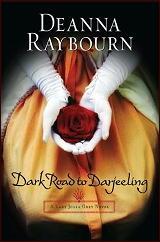
The honeymoon of Lady Julia Grey and enquiry agent Nicholas Brisbane has been interrupted by the arrival of Julia’s sister, Portia, and brother, Plum. Jane, Portia’s lover of many years, desperate to have a child, married, moved to a tea plantation in India, is now pregnant.
She is also a widow, her husband having died under somewhat suspect circumstances. If Jane’s impending child is male, he will be the heir to the plantation. Julia, Nicholas, Portia and Plum must keep Jane and the child safe as well as uncover a murderer, had it been murder.
It takes a very good book to keep me reading until 3 a.m. This book did just that.
Ms. Raybourn creates wonderful characters. Where Lady Julia starts off feeling reckless and stubborn, and her husband, Nicholas, overbearing and harsh, there is growth within the story where both characters learn and gain an understanding both to each other and to the reader.
Julia’s sister Portia, brother Plum, maid Morag, and all the secondary characters have weight and substance. None of the characters are two-dimensional extras; rather each plays an important role in the development of the plot.
he use of humor is delightful. It is often used to define the characters and relationships. When Portia is confronted by a less-than-fragrant smell, she states, “Julia, we are Englishwomen. We are not cowed by a little authentic local flavor.”
Raybourn’s voice and dialogue effect a feeling both character and of period. In addition to which her excellent descriptions establish a strong sense of place and time.
Although one could consider this romantic suspense, it is not a fluffy book and has more layers than most. One should not dismiss it casually. The lightness is tempered by reminders of harsh reality which are both thought-provoking and introspective.
This is a story of relationships and their definitions, of neglect and its results, of loss and strength and survival. There is a mystery, a quite good one, in fact, with a tragic and emotional finale.
Ms. Raybourn has taken a book, and a series, which could be simple light entertainment and infused it with depth and impact.
Rating: Very Good.
The Lady Julia Grey series —
1. Silent in the Grave (2006)
2. Silent in the Sanctuary (2008)
3. Silent on the Moor (2009)
4. Dark Road to Darjeeling (2010)
5. The Dark Enquiry (2011)
Mon 25 Jul 2011
REVIEWED BY MICHAEL SHONK:
OSS 117: CAIRO, NEST OF SPIES. Gaumont, 2006. Music Box Films (US), 2008. Original title: OSS 117: Le Caire, nid d’espions. Subtitled. Jean Dujardin (Hubert Bonnisseur de la Bath, alias OSS 117), Bérénice Bejo (Larmina), Aure Atika (Princess Al Tarouk). Scenario by Jean-François Halin, based on the novel OSS 117 by Jean Bruce. Adaptation & dialogue by Jean-François Halin & Michel Hazanavicius. Music by Ludovic Bource & Kamle Ech Cheikh. Director: Michel Hazanavicius.

Cairo, 1955. The Cold War is hot here. The British struggle to keep control of the Suez Canal. There is a rising Arab nation seeking freedom from the West. Toss in some Muslim terrorists, some Nazis, a missing Russian ship full of weapons, and a missing French spy OSS 238 and the Middle East is ready to explode. The French government turn to OSS 117 to make the Middle East safe.
“No problem,” responds the smug spy.
Billed as a spy spoof featuring the French James Bond, the hilarious parody undersells itself. Cairo, Nest of Spies is also a wonderful comedy satirizing the insensitivity of the West to other cultures such as the Muslims.
Hubert tells his beautiful Egyptian assistant that he always learns the language of the native people in every country he visits. For his trip to Egypt he learned hieroglyphics and ignored Arabic. OSS 117 stops a Muezzin from conducting the Muslim Morning prayer because the noise was keeping him awake, and he is clueless to why anyone is upset by his actions.
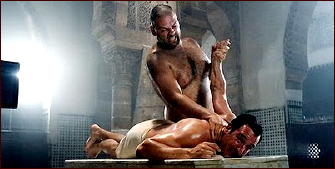
Never too serious, the film does take its always successful shots at Bond, as well as the 60’s Eurospy genre that includes the original OSS 117 films. Those who find Sean Connery’s 007 too perfect, from his repeated escapes from sure death to his expert attitude about everything, will enjoy OSS 117 ‘s version of those qualities.
Jean Dujardin is the perfect mimic of Connery’s Bond. From a raise of an eyebrow to the way he stands before he is attacked, Dujardin looks the part of Bond. The only difference between the two is Dujardin’s version makes you laugh.
Hubert is a clueless colonialist who gives pictures of French President Rene Coty for tips to native workers. He is in denial about his sexuality, while he can verbally seduce any woman, he prefers fighting with men over sex with women. He is not stupid. OSS 117 can learn any language, dance, or musical instrument almost immediately. He is just blind to any culture or belief outside his own male Western world.
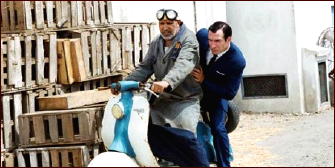
While filmed in 2006, Cairo, Nest of Spies has the visual look of a 1950s-60s spy film such as Dr. No and Hitchcock’s The Man Who Knew Too Much. As you view this clip from IMDb.com, notice how the look and music mimics early Bond films and John Barry’s music.
Those who want to learn more about OSS 117’s past, how he pre-dates Fleming’s Bond, his 265 novels, his other films and attempts at television, I recommend a visit to the Double O Section website.
The OSS 117: Cairo, Nest of Spies official website offers some more trailers to view as well as more information about the makings of the film.
YouTube has trailers and samples of the other OSS 117 films. Most are in French except for this trailer for the American release of OSS 117 Is Not Dead (1957).
Sun 24 Jul 2011
KAREN KIJEWSKI – Kat’s Cradle. Doubleday, hardcover, March 1992. Bantam, paperback, December 1992.
Throughout the decade she was active, the 1990s, Karen Kijewski was a prolific and well-regarded mystery writer. She won or was nominated for several awards, and she seemed to be doing well sales-wise. Living in northern California at the time, and perhaps still, she seems to slipped off the map since her final book (so far), Stray Kat Waltz (1998), the ninth adventure for her female PI character, Kat Colorado.
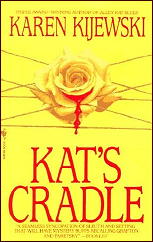
I admit to being optimistic to adding the parenthetical phrase (so far) in that line above. It’s been 13 years since that last outing, though, so I’d have to agree that the chances are slim to none that we’ll ever see another entry in the series. Someone once suggested to me that when her contract ran out and wasn’t renewed, she decided to call it quits, but as I say, that’s only hearsay, if not an out and out and totally wild guess.
In Cradle Kat is hired by a young heiress, Paige Morell, whose strong-willed (i.e., domineering) grandmother has just died. She never knew her parents, and she wants Kat to find out more about them. While she takes the job, Kat knows that digging around in the past may bring up more than her client might want to know, but convincing her of that is another story. (And not this one.)
Her client also appears more than a tog unstable, with many emotional ups and downs as the story goes along. Under the circumstances, it’s nothing very surprising, but it also becomes clear that there’s several important things she’s not telling. Otherwise the case seems straightforward enough, but not so. It turns out to be a thoroughly exhausting affair for Kat, both physically and otherwise.
That Kat is unable to establish on her part an emotional distance away from the case she’s on is part of the problem. This is Ross Macdonald territory, not Hammett, but Kat is no Lew Archer, who often observes but fails to get involved himself.
Besides the investigation she finds herself an integral part of, in more ways than one, she allows her relationship with Hank, her close cop friend who lives in Las Vegas – which is more than a short hike from the Sacramento area, her base of operations – to wither away.
Let’s change that last phrase to something more akin to “actively pushes away.†My feeling is that PI’s should not allow themselves to become romantically involved with clients, suspects, or suspects’ families and friends, nor can you always foresee what will happen on the rebound. There’s more than enough of a hint here to tell you what I found as a fatal flaw to this book’s telling, and you should immediately forget I said anything, if you ever intend to read this book.
In any case, it was obviously Karen Kijewski’s intent to write a wrenching tale of dysfunctional family relationships, and that is exactly what she did. Kat is lucky to have escaped alive, in more ways than one.
The Kat Colorado series:
1. Katwalk (1988)
2. Katapult (1990)
3. Kat’s Cradle (1991)
4. Copy Kat (1992)
5. Wild Kat (1994)
6. Alley Kat Blues (1995)
7. Honky Tonk Kat (1996)
8. Kat Scratch Fever (1997)
9. Stray Kat Waltz (1998)
Sun 24 Jul 2011
Pulp Writer VICTOR MAXWELL, Part 2
by Terry Sanford
The first part of this article on pulp writer Victor Maxwell appeared earlier here on this blog. As Monte Herridge pointed out in the comments that followed, there was a quasi-autobiography of Maxwell in the January 5, 1929, issue of Detective Fiction Weekly. Monte, by the way, is indeed a DFW scholar. Now to be honest, I’ve never put a lot of stock in DFW’s authors’ writing about themselves because some were obviously pure fiction.
Now what Max did was a blend. He had his Halloran character meet Victor Maxwell. Probably made perfect sense to him since both names were fiction. Halloran is telling young Willis of his encounter the next day. The germane part is very brief and the underlined words are my way of highlighting new information.
“Well he says as how he began what he calls his ‘nefarious career,’ whatever that is, in New Yawk on the Sun, an’ went from there to the New Yawk City News Association, an’ then to Brooklyn an’ other bad luck burgs Includin’ Wilmington, Delaware and Boston, which went Democratic – yuh know the place — an’ then how his feet got to itchin’ and he come out West, infestin’ for some twenty years all the live burgs an’ them as was foredestined to become live burgs.
“Most of the time, he says, he was a newspaperman, but once or twice he deteriorated into bein’ an editor, an’ once he was an advance man for a show. One time, he says, he ran for sheriff an’ got as far as gettin’ the Democratic nomination; an another time he says he was a special agent for the Governor of Oregon, doin’ high-class gumshoe work after Wobblies an’ such.
“An it was then, he says, that he run across Don Thompson, who writes for DFW an’ he thought Thompson was a right smart guy. From what he says I got a hunch, too, that he done some Intelligence work durin’ the war; but yuh can’t tell about those guys.”
BIBLIOGRAPHY
A. Non-Crime Pulps.
* The Little Girl Who Got Lost. The Popular Magazine, Jan 20 1916.
* Why Arabia Kissed Me. The Popular Magazine, Aug #2 1916.
* No Show at All. The Popular Magazine, Apr 5 1917.
* Opals Are Unlucky. The Popular Magazine, Apr 20 1917.
* “Honest Jawn”. The Popular Magazine, May 20 1917.
* Doubling the Double Cross. The Popular Magazine June, 7 1917.
* A Personal Vengeance. The Popular Magazine, June 20 1917.
* No Imagination. The Popular Magazine, Sept 7 1917.
* Mushrooms and Airships. The Popular Magazine, Sept 20 1917.
* Justified Piracy. The Popular Magazine, Dec 20 1917.
* The Making of a Hero. The Popular Magazine, July 20 1928.
* I Remember When. Railroad Man’s Magazine, Feb 1930.
* Check and Double Check. Railroad Man’s Magazine, Jan 1931.
* The Side-Rod Bender. Railroad Man’s Magazine, Feb 1931.
* Rolling Sixty-Five or Better. Short Stories, Oct 10 1931.
* Red Lantern Oil. Railroad Stories, Aug 1932.
* The Deadhead Passenger. Railroad Stories, Nov 1933.
* One Thing Leads to Another. Street & Smith’s Complete Stories, May 20 1934.
* Crazy Like a Fox. Street & Smith’s Complete Stories, Sept 3 1934.
* The Payoff Comes Last. Street & Smith’s Complete Magazine, June 1935.
* A Good, Smart Girl. Street & Smith’s Complete Magazine, July 1935.
B. Detective Magazines. DFW indicates variously Flynn’s, Flynn’s Weekly, Detective Fiction Weekly.
* The Plainly Marked Track. DFW, Aug 8, 1925.
* The Work Of An Artist. DFW, Sept 5, 1925.
* Threads Of Evidence. DFW, Sept 19, 1925.
* What The Cipher Told. DFW, Oct 24, 1925.
* The Honest Thief. DFW, Nov 7, 1925.
* Another Use For Water. DFW, Dec 5, 1925.
* Three Out On Christmas. DFW, Dec 12, 1925.
* Mister Somebody Else. DFW, Jan 9, 1926.
* The Ghost Burglar. DFW, Feb 13, 1926.
* A Jeweler’s Reputation. DFW, Feb 27, 1926.
* Two In The Dark. DFW, Mar 27, 1926.
* The Hole In The Chimney. DFW, May 8, 1926.
* The Haunted Street. DFW, Aug 21, 1926.
* For A Point Of Honor. DFW, Sept 4, 1926.
* Quick Work. Sept 11, 1926.
* All Covered Up. DFW, Sept 25, 1926.
* Something New in Vanities. DFW, Oct 2, 1926.
* Riordan Seems Stupid. DFW, Oct 23, 1926.
* A Darned Good Tailor. DFW, Nov 20, 1926.
* An Open And Shut Case. DFW, Dec 11, 1926.
* Died From Other Causes. DFW, Dec 18, 1926.
* Politics. DFW, Feb 26, 1927.
* The Staples Case. DFW, Mar 5, 1927.
* The Bomb. DFW, Mar 12, 1927.
* The Stolen Street Car. DFW, Apr 9, 1927.
* Framed. DFW, Apr 23, 1927.
* The Power Of The Press. DFW, June 11, 1927.
* Applied Psychology. DFW, July 16, 1927.
* All Crossed Up. DFW, Oct 15, 1927.
* Riordan Uses Tact. DFW, Oct 22, 1927.
* Straight Police Work. DFW, Oct 29, 1927.
* One Thing After Another. DFW, Feb 18, 1928.
* The Truth About The Prince (Pt.1). DFW, Feb 25, 1928.
* The Truth About The Prince (Pt. 2). DFW, Mar 3, 1928.
* The Truth About The Prince (Pt.3). DFW, Mar 10, 1928.
* Tod Nevis Tells The Story. DFW, Apr 21, 1928.
* A Young Man In Trouble. DFW, May 5, 1928.
* The Other Side Of The Story. DFW, Sept 1, 1928.
* He Learned To Use His Eyes. DFW, Nov 10, 1928.
* The Dark Finger-Prints. DFW, Dec 1, 1928.
* Mostly Head Work. DFW, Dec 15, 1928.
* Too Good To Be Straight. DFW, Jan 5, 1929.
* Riordan Foils A Press Agent. DFW, Jan 26, 1929.
* The Murder Of Joe Parrish. DFW, Feb 16, 1929.
* Marked Money. DFW, Mar 16, 1929.
* Evidence Of Murder. DFW, June 22, 1929.
* Protection Money. DFW, Aug 17, 1929.
* The Bullet Holes In The Ceiling. DFW, Oct 12, 1929.
* Suspicion Of Murder. DFW, Jan 25, 1930.
* On Getting Out Of A Jam. DFW, Feb 1, 1930.
* Hit-And-Run. DFW, Apr 19, 1930.
* Brass Buttons. DFW, Aug 2, 1930.
* The Invisible Death. DFW, Sept 6, 1930.
* Two Confess Murder. DFW, Sept 20, 1930.
* The Hazardous Path. DFW, Oct 18, 1930.
* Fast Time On The Main Line. DFW, Nov 1, 1930.
* A Fine Night For Murders. DFW, Feb 28, 1930.
* One Of These Seven. All Star Detective Stories, May 1931.
* The Man Who Left No Trace. DFW, May 2, 1931.
* Handicapped By Facts. DFW, May 16, 1931.
* Very Well Framed. DFW, June 10, 1931.
* Missing Persons. DFW, June 27, 1931.
* Accidental Death. DFW, Aug 15, 1931.
* Halloran Makes A Case. DFW, Sept 12, 1931.
* The Morning Alibi. DFW, Sept 26, 1931.
* The Convicting Alibi. DFW, Dec 19, 1931.
* Captain Brady Takes A Cue. DFW, Jan 23, 1932.
* The Things They Saw. DFW, Mar 5, 1932.
* More Than Satisfied. DFW, Apr 9, 1932.
* The Corpus Delicti. DFW, June 11, 1932.
* The Station House Murder. DFW, July 2, 1932.
* Halloran Spots A Boner. DFW, Dec 31, 1932.
* Pearls Before Swine. DFW, Mar 4, 1933.
* The Serge At 2242. DFW, May 20, 1933.
* Find The Woman In Red. DFW, July 15, 1933.
* The Trail To The Treasure. International Detective Magazine, Oct 1933.
* Way Up In The Air. DFW, Nov 11, 1933.
* The Girl In The Hidden Cell. DFW, Dec 9, 1933.
* The Old Lummox. DFW, Dec 30, 1933.
* The Death In The Binoculars. DFW, Mar 31, 1934.
* Straws Of Doom. DFW, July 7, 1934.
* Cold Decked. DFW, Sept 29, 1934.
* Murder On The Limited. DFW, Dec 29, 1934.
* The High-Frequency Eliminator. DFW, June 8, 1935.
* A Clever Job. DFW, July 20, 1935.
* Shake And Shake Again. DFW, Oct 2, 1935.
* Loose End. DFW, Jan 11, 1936.
* Four Petrified Men. DFW, Feb 15, 1936.
* Diamond Death Trail. DFW, Mar 28, 1936.
* The Cart Before The Horse. DFW, June 20, 1936.
* Dangerous Millions. DFW, Aug 1, 1936.
* Dames Are Poison. Detective Action Stories, Oct 1936.
* On The Mayor’s Doorstep. Detective Action Stories, Dec 1936.
* Willis to Riordan to Halloran. DFW, Dec 26, 1936.
* The Thunderbolt. DFW, July 3, 1937.
* The Suicide Clues. DFW, Aug 28, 1937.
* The Hundred Flyaway Skulls. Detective Action Stories, Apr-May 1937.
* The Devil Wears Diamonds. DFW, July 1, 1939.
* A Trick For Halloran. New Detective Magazine, Nov 1943.
* Murder, Ahoy! New Detective Magazine, Jan 1944.
Corrections and additions are most definitely welcome.
SOURCES:
Michael L. Cook & Steven T. Miller: Mystery, Detective, and Espionage Fiction: A Checklist of Fiction in U.S. Pulp Magazines, 1915-1974.
The FictionMags Index.
The personal files of Maxwell Vietor, aka Victor Maxwell.
Sat 23 Jul 2011
REVIEWED BY BARRY GARDNER:
EDNA BUCHANAN – Miami, It’s Murder. Britt Montero #2. Hyperion, hardcover, January 1994. Avon, paperback, 1995.
Buchanan’s first Montero, Contents Under Pressure, got a lot of good press, though I liked it less than most because of a to me unbelievable plot.
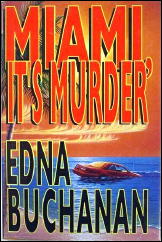
[In Miami, It’s Murder, the city] is plagued by a serial rapist. Britt is doing the story, and has annoyed the police by printing information they wanted withheld. At the same time, a friend of hers on the police department is being forced into retirement because of a bad heart, and he is agonizing over cases he never broke.
One was the 20-year-ago sexual murder of a young girl. He was convinced of the guilt of a young man who is now a grown politician running for governor, but could find no evidence. Britt decides to dig into the old case and see what she can find.
She continues to write about the rapist, and begins to get threatening letters from him. A series of deaths begin to occur, some seemingly accidental, some not, all involving people who were suspected of old murders but never convicted. Not surprisingly, all three situations — rapist, politician, murders — are eventually resolved.
As with the first book, the narration is excellent, the writing fast-paced and effective. Again, too, there are plot elements that won’t wash. Britt’s acceptance of her cop friend’s assertion of the politician’s guilt without any real evidence makes either her or the author just plain foolish; as does her eagerness to personally offend the man without even her paper’s knowledge or concurrence.
More so than in the first novel, she often acts foolishly. But the main problem I have with the book is that it (and Montero) ethically offended me. I can’t go into reasons without giving away the plot, so I’ll just say neither she nor the author seem to have the same ethical values that I do. No go, Montero.
— Reprinted from Ah, Sweet Mysteries #8, July 1993.
Bibliographic Notes: In spite of Barry’s clearly stated misgivings, Miami, It’s Murder was nominated for an Edgar in 1995.
For more on the author, a visit to her Wikipedia page may suffice: “As one of the first female crime journalists in Miami, she wrote for the Miami Beach Daily Sun and the Miami Herald as a general assignment and police-beat reporter. She won a Pulitzer Prize in 1986 for general reporting.” She is also the author or co-author of 17 crime novels, including the nine Britt Montero novels listed below.
For even more, check out the author’s own website. There’s much of interest there.
The Britt Montero series —
1. Contents Under Pressure (1992)
2. Miami, It’s Murder (1994)
3. Suitable for Framing (1995)
4. Act of Betrayal (1996)
5. Margin of Error (1997)
6. Garden of Evil (1999)
7. You Only Die Twice (2001)
8. The Ice Maiden (2002)
9. Love Kills (2007)
Thu 21 Jul 2011
Posted by Steve under
Reviews[4] Comments
THE BACKWARD REVIEWER
William F. Deeck
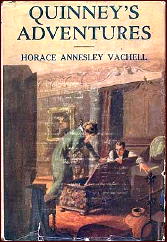
HORACE ANNESLEY VACHELL – Quinney’s Adventures. George H. Doran, US, hardcover, 1924. Originally published in the UK: John Murray, hardcover, 1924.
Joe Quinney is an earlier, more subdued version of Jonathan Gash’s Lovejoy. While Quinney has an eye for antiques, he hasn’t Lovejoy’s ability to identify them immediately. He also lacks Lovejoy’s ability not to make money. Well, for the most part. Occasionally Quinney has been fooled by some unscrupulous dealers.
The 11 stories in this book deal with Quinney’s purchases of and investigations into antiques, including one locked room murder. They aren’t all mysteries, by any definition, and several deal with the genuine occult, if there is such a thing.
Each story is interesting, but reading one after another probably would be too much of a reasonably good thing.
— From The MYSTERY FANcier, Vol. 12, No. 3, Summer 1990.
Bibliographic Notes: It’s hard to imagine that many browsers on the Internet are going to be Googling the author’s name and end up here. I’m sure his is a name long forgotten.
Even so, you (as I) may be surprised to learn that Vachell has some 18 titles in Hubin, including one marginally criminous entry, one play, one collaboration with another author, and several story collections. Nor was the book Bill reviewed the only appearance of Joe Quinney. He showed up in one novel and three collections, including this one.
Inexpensive copies (under $30) can be found on the Internet, but don’t count on the condition being more than Good, and the overseas postage fees may match the price of the book. If you’d prefer a copy in Nice condition with a Dust Jacket, such as the one shown, be prepared to spend $250 or so.
Wed 20 Jul 2011
REVIEWED BY DAN STUMPF:
TERROR IN A TEXAS TOWN. United Artists, 1958. Sterling Hayden, Sebastian Cabot, Carol Kelly, Eugene Martin, Ned Young, Victor Millan, Frank Ferguson. Screenwriter: Ben Perry (as a front for Dalton Trumbo). Director: Joseph H. Lewis.
Mention of Nedrick Young [in my previous review ] may have baffled some of you out there, so I should say he was a sometime-actor/sometime screen-writer who wrote Jailhouse Rock and won an Oscar for The Defiant Ones, which he had to accept under a pseudonym because he was black-listed.
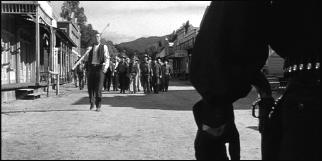
He also appears uncredited and disguised by a heavy beard in House of Wax (1953) but Young’s chief claim to fame is his portrayal of the sympathetically loathsome gunfighter in a little cheapie called Terror in a Texas Town (1958).
This was the last feature film of director Joseph H. Lewis, and a fitting cap to a career that started out in B-westerns and veered through such films as Gun Crazy and So Dark the Night. Terror moves with that manic intensity sometimes seen within the febrile reaches of desperate cinema, parading its clichés like a magician doing card-tricks, flashing one at us where we expect to see another, till the whole thing speed-shuffles itself into one of the most bizarre shoot-outs in the movies.
In all this delirium, there’s little time for serious acting, which is why it’s surprising to see some very nice turns here from thespians whose careers were mostly marginal. Sterling Hayden does a very creditable job as a Swedish sailor (a thematic echo of John Wayne in The Long Voyage Home) out west to join his father who has bitten the dust, courtesy of gluttonous Land Baron Sebastian Cabot.
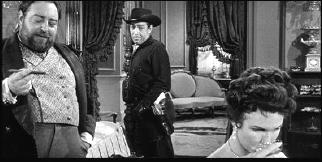
Someone named Carol Kelly plays a poignantly masochistic kept woman, whose keeper is the declining gunfighter Johnny Crale, played here by Nedrick Young.
Young somehow brings real feeling to a stock character here. Black-clad, with six-guns at his hips, he strides about with a weary grace, his balletic movements always somehow tired and over-practiced, as he goes through the motions of pleading with his victims not to make him fulfill his destiny, or begs his opponent to get closer for a fair fight.
That bit happens in the final confrontation in the middle of a dusty street, and it seems less a cliché than one would think, thanks to Young’s assured playing and Lewis’s vigorous direction.
Perhaps the performances stand out because director Lewis puts them in such stark relief. Or it may be just a matter of budget that there are no extras in this Texas town till the last reel. Whatever the case, Terror lingers in the memory as an authentically strange film and even a rather good one.
« Previous Page — Next Page »



